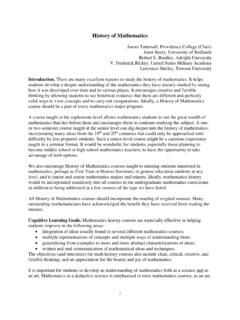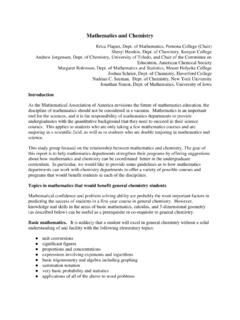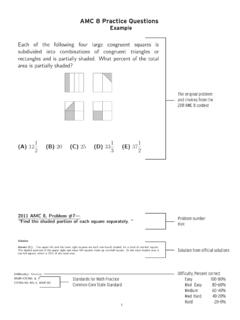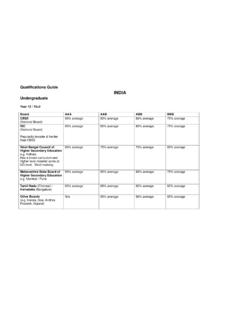Transcription of Mathematical Modeling
1 Mathematical Modeling Jason Douma, University of Sioux Falls (Chair) Ricardo Cortez, Tulane University Michael Jones, Mathematical Reviews (AMS) Talithia Williams, Harvey Mudd College. Preliminary Report Committee Joseph Malkevitch, York College (CUNY) (Chair) Charles Collins, University of Kentucky Dawn Lott, Delaware State University Judith Miller, Georgetown University. Introduction The muscles of mathematics are connected to the bones of experimental science by the tendons of Mathematical Modeling . Glenn Ledder [3]. The pursuit of abstract Mathematical knowledge for its own sake holds a venerable and well-deserved position among the activities worthy of an educated person.
2 However, as suggested by Ledder s metaphor in the preface to his textbook on Mathematical applications to biology, the field of mathematics connects to the full richness of human experience through the process of Mathematical Modeling . Much of the relevance and value to be found in the study of applied mathematics in the 21st Century follows from its ability to capture the structure of observable experiences and, consequently, to support our efforts to solve a wide array of real and meaningful problems. Because Mathematical Modeling plays a vital role in delivering the power of mathematics to the needs of science, commerce, politics, and so many other areas of human interest, undergraduate programs in mathematics should seek to provide intentional, substantive learning opportunities for their students in the experience of Mathematical Modeling .
3 However, the manner in which these experiences are situated in the curriculum may vary considerably, depending on the mission, size, resources, and setting of each institution. This report identifies considerations that would be common to the teaching and learning of Mathematical Modeling regardless of implementation, outlines several viable ways to situate Mathematical Modeling within the undergraduate program (not all of which entail stand-alone courses in Modeling ), and provides resources to assist with the development of Modeling curricula. Definition of Mathematical Modeling Mathematical Modeling is best understood as an active process, rather than a static object of study.
4 In practice, Modeling entails a systematic approach to problem solving that brings the techniques and structures of mathematics to bear in an effort to describe, understand, and make predictions about a wide range of empirical phenomena. Genuine Mathematical Modeling is dynamic and iterative in a way that isolated story problems or brief applications (often included as short examples near the end of each section in a mathematics textbook) are not. A recent report from a joint SIAM-NSF workshop drew a similar distinction between Mathematical Modeling and Mathematical models : Mathematical Modeling is an abstract and/or computational approach to the scientific method, where hypotheses are made in the form of Mathematical statements (or Mathematical models), which are then used to make predictions and/or decisions.
5 The quality of these models is then examined as part of the verification process, and the entire cycle repeats as improvements and adjustments to the model are made. The teaching of models, by contrast, is simply a presentation of the final product, and does not provide many insights into the process or the understanding gleaned from s like the difference between painting a picture and looking at paintings in a museum. [4] Although there is surely something to be gained by introducing students to significant and interesting Mathematical models at points throughout the undergraduate mathematics curriculum, this report is primarily concerned with the teaching and learning of Modeling in the undergraduate mathematics curriculum.
6 By definition and design this should entail an iterative process in which students establish assumptions, develop a Mathematical structure consistent with those assumptions, produce hypotheses or conjectures that are generated by the Mathematical structure, test the hypotheses against empirical evidence, and then revise/refine the model accordingly. The physical sciences and engineering fields have long served as the epicenter for Mathematical Modeling in the undergraduate curriculum. This is not at all surprising in light of the central role that Mathematical language has played in these fields, dating at least as far back as the scientific revolution.
7 However, in the past century--and even in just the last few decades--many other disciplines have emerged as fertile ground for Mathematical Modeling . These areas include biology ( , bioinformatics, ecological studies), medicine ( , epidemiology, medical imaging), information science ( , neural networks, information assurance), sociology ( , social dynamics, social networks, dating/matchmaking services), political science ( , apportionment, social choice), business operations ( operations research, resource optimization), economics ( , game theory, forecasting, market equilibrium), and finance ( , option pricing, portfolio optimization).
8 While many classical models are continuous in nature (often developed in the context of differential equations), it should be noted that discrete, stochastic, and data-driven methods provide the Mathematical infrastructure for many significant applications of mathematics as well. A course that is designed to provide students with a general introduction to Modeling should consider integrating methods from several/all of these areas. Audience and Prerequisites Traditionally, a Modeling course might appear as a junior/senior level offering that would be taken only after calculus and differential equations. When positioned as an upper-division offering, a Mathematical Modeling course is able to leverage a more extensive toolbox of prerequisite skills.
9 Indeed, an upper-division Modeling course can serve as an excellent vehicle for recalling and strengthening students working knowledge of the mathematics they learn throughout the core curriculum. However, there is no intrinsic reason why meaningful experiences with Modeling could not occur at virtually any place in the undergraduate mathematics curriculum. In fact, the latest standards for K-12 mathematics, the Common Core State Standards, call for students to develop proficiency in Mathematical Modeling , which will increase the number of undergraduates that arrive at universities with some Modeling experience [2].
10 The United States Military Academy, for example, features an integrated sequence of four mathematics courses (Discrete Dynamical Systems and Introduction to Calculus, Calculus I, Calculus II, and Probability & Statistics), throughout which students engage in Mathematical Modeling [1]. Significant Modeling experiences are often presented in the form of Interdisciplinary Lively Application Projects (ILAPs), many of which are available in a volume published by the MAA. Macalester College serves as an example of a relatively small liberal arts college that offers a Modeling -intensive track (within the Mathematics Major) in Applied Mathematics and Statistics.










